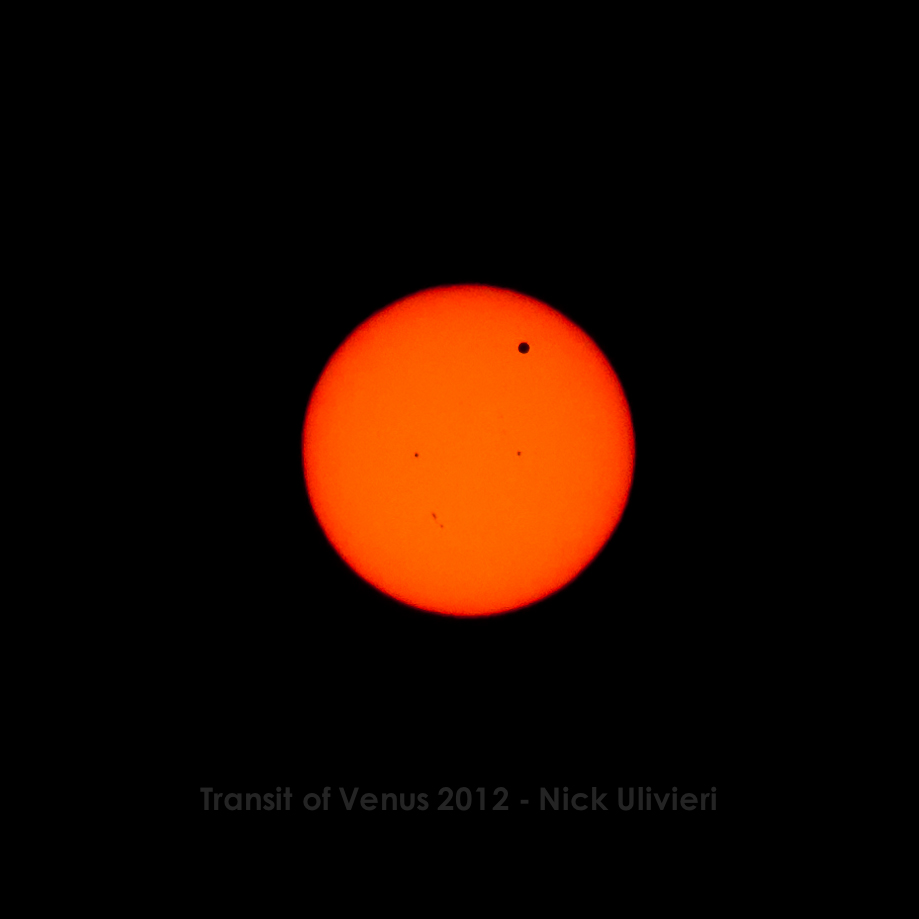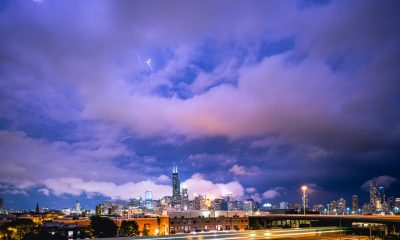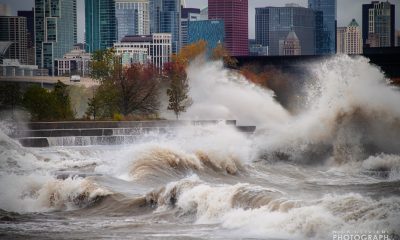
The Transit of Venus 2012
Venus is visible in the upper right hand corner of the Sun’s disc. Sunspots are also visible on the surface of the sun.
Nick Ulivieri | 6.14.12
On June 5th, 2012 sky gazers were treated to a rare celestial treat – Venus transiting the sun. This occurrence is quite rare in terms of predictable celestial phenomena. The transits typically happen in pairs eight years apart, which are themselves separated by more than a century – The next transit won’t happen until December 2117. To put this in perspective, there have only been 7 observed transits (including this most recent one) since the invention of the telescope in 1609! This particular transit lasted approximately 6 hours, and was visible to most of the world except for most of South America, and western Africa.
Venus is the second closest planet to the sun and is named for the Roman goddess of love and beauty. The planet orbits at an average distance of 67 million miles from the sun and is similar in size, gravity and composition as our home planet. Venus is also the brightest natural object in the night sky, aside from the Moon.
While this may not be the most impressive visual sight to the casual observer, especially when compared to a solar eclipse, the orbital choreography that took place is quite fascinating the more you think about it. Considering the various orbits between Venus and Earth, along with the inclination of those orbits, this relative “speck of dust” just happened to pass directly between us and the sun 93 million miles away.
Also consider that Venus is 23 million miles away from the Earth, meaning that there are 67 million more miles of space between this small speck black speck and the sun itself. Translation: The sun is huge!
Getting the shot
When I first learned about the upcoming transit a few months ago, I was going to go all out; rent a huge lens, rent the proper filters, etc. However, client work got crazy, and I wasn’t sure if I wanted to invest that kind of cash in something that could be invisible due to weather. Naturally, June 5th rolled around and I was upset at myself for not spending the time and money to do it “right”. Instead of getting upset, I figured it was a great opportunity to experiment.
At that moment, I knew I’d have to rely on my 70-200mm telephoto lens, but I had to figure out a way to filter out a large amount of sunlight so that I could get a decent shot – The sun is unbelievably bright after all. I tried a welder’s lens, and a split DVD, but my initial tests early in the morning were less than impressive. I didn’t have time to get the proper solar filter I should have used, so it finally dawned on me – Get some eclipse viewing glasses. Well, I didn’t have those lying around so I took a quick trip to the Adler Planetarium to pick a few pairs up to tear apart, and use to watch with my own eyes.
Once I had the glasses, I could begin building my makeshift filter, pictured below. I simply cut a round lens cover out of black mat board, cut a smaller hole in the middle of that, and taped in one of the eclipse viewing glasses lenses – easy.
I took some practice shots to get my settings down and waited for the transit. With my camera on a tripod, my settings were as follows: ISO 320, f/7.1, speed of 1/80 sec. The biggest edit I made was cropping it down – way down! Even with a 200mm telephoto, the sun is pretty small in the original shot.
Not only did I get a cool photo with “basic” equipment, I also have some sweet eclipse glasses. So now, when my mom tells me not to look into the eyes of the sun I can tell her, “mom, that’s where the fun is” and do it safely.
-Nick






